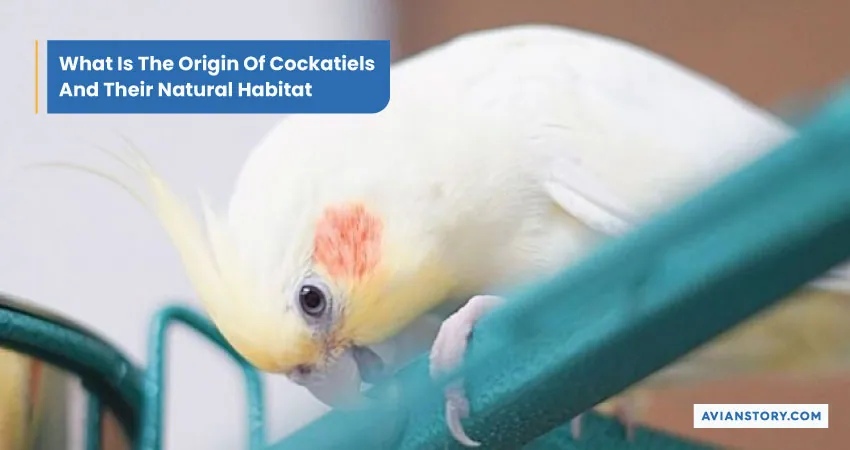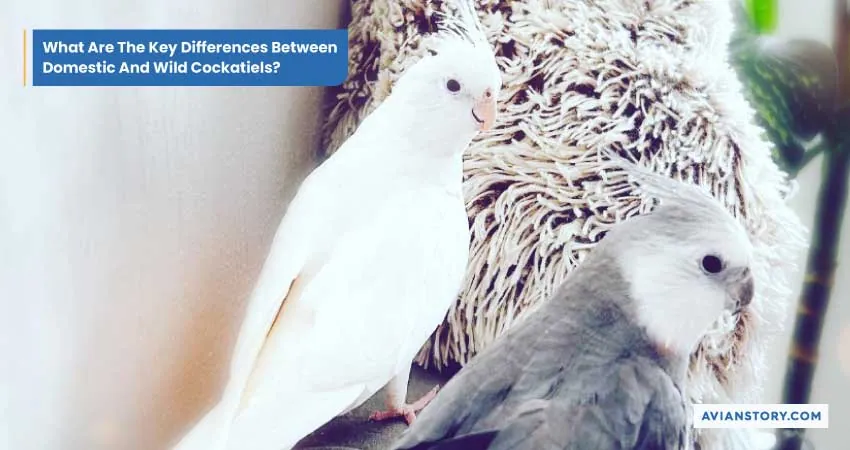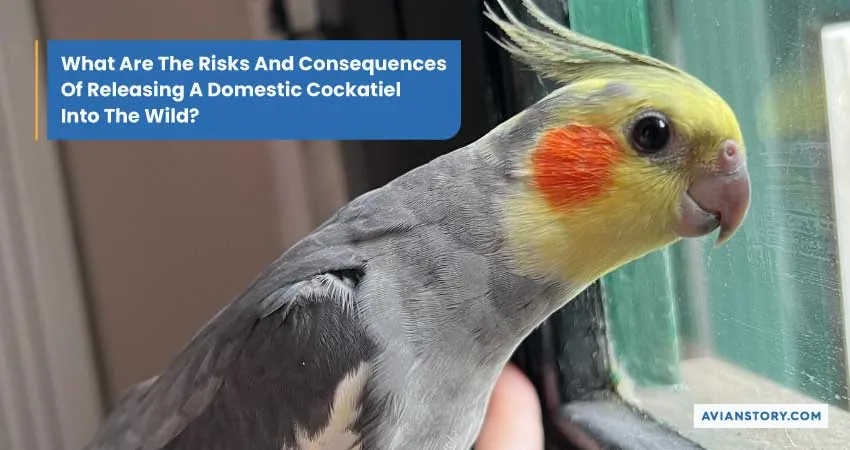Can A Cockatiel Survive In The Wild – Possibilities Reviewed!
Cockatiel birds are among the most charming pet birds to keep. However, keeping them in the compound without escaping is challenging, and most owners wonder whether they will survive in the wild environment.
So, can a cockatiel survive in the wild? Yes. Cockatiels are wild birds that have survival adaptations in the wild environment. However, domestic or captive-bred cockatiels may not survive in the wild environment and therefore need risk considerations before release.
Let’s review the survival chances of cockatiels in the wild environment and the potential risks of releasing domestic cockatiels in the wild. In addition, we shall also discuss the necessary survival adaptations of cockatiels.
What Is The Origin Of Cockatiels And Their Natural Habitat

Cockatiels originate from Australia, commonly in fairly open grasslands. They are also found in arid-deserts habitats with enough water or moisture to survive. Cockatiels love open eucalyptus forests near rivers and lakes for their survival.
Their natural habitat influences cockatiel behavior greatly, as they are seen in flocks while foraging for seeds. Mating cockatiel partners socialize within the flock and are seen grooming each other as they feed.
In the wild, cockatiels breed throughout the season and remain together, preening each other’s heads and crests when not breeding. They live in flocks to increase their security from humans who consider them a threat since they feed on seeds.
According to the IUCN list, cockatiels are of the least concern regarding extinction. Because they reproduce in large numbers to cater to the birds killed by predators and humans.
What Are The Key Differences Between Domestic And Wild Cockatiels?

Domestic cockatiels are bred or picked when young and raised in captivity, while wild cockatiels are born and raised in the wild environment. The difference in their habitats greatly affects how they behave and survive.
Let’s look at the differentiating aspects of the two birds.
Behavior
Wild cockatiels live in groups of several mating partners known as flocks. During breeding, mates break from the flock and find their own breeding sites. They also mate throughout the season in hollow tree cavities made by other birds.
Mating partners are seen preening each other’s heads and crests. The flocks spend their mornings singing and socializing before going to forage in the fields.
On the other hand, domesticated cockatiels are trained and tamed to live in solitary or pairs. They are treated as pets and even taught how to talk and sing along with human beings. Their behavior is more of a pet with a programmed routine of being fed and released to perch in the compound.
Diet
Wild cockatiels are majorly herbivores and feed on plants and seeds from weeds, shrubs, and grass. In the wild, they also feed on fruits, flowers, and wild berries from the forest. These wild birds forage on grains and cereals plantations and may eat small insects.
On the other hand, domesticated cockatiels have a controlled diet where they are fed whole beans, vegetables, carrots, fruits, and cockatiel pellets. Domesticated cockatiels majorly feed on most household food apart from dairy products, avocados, and garlic.
Survival Skills
Domesticated cockatiels have little need for survival skills and adaptations since they are protected in the cockatiel cage setups. They feed, exercise, and spend most of their time in cages safe from predators.
Wild cockatiels are exposed to predators and environmental conditions that require them to be well-adapted to survive. They have solid wings for flight to help navigate and evade predators. They live and forage in flocks for security from predators.
Impacts Of Domesticating Cockatiels
Listed below are the positive effects of domesticating cockatiels.
- Domestication has led to breed improvement through cross-breeding to produce birds that are tolerant to diseases and with a variety of colors.
- Domestication also paved the way for the birds to be trained to mimic sounds and even talk.
- They are perfect pets to live with, helping avoid boredom in households.
- Domesticating cockatiels also have increased their lifespan with proper care.
Let’s look at the negative impacts of domesticating cockatiels.
- Loss of their social behavior where they used to live in flocks
- Disruption of their mating cycle, primarily when domesticated alone
- Some cockatiels may die due to changes in the environment and diet
- Some pluck their feathers when aggressive due to the captivity routine
Can Domestic Cockatiels Survive In The Wild?

Yes. Domestic cockatiels can survive in the wild. But several factors influence their ability to survive in the wild since they are not adapted to the wild environment. The wild environment is harsh and has predators; therefore, a domestic cockatiel requires skills to survive in the new environment.
Below are factors that influence the survival of cockatiels in the wild and the essential skills needed in the wild for survival.
Weather Conditions
For domestic cockatiels to survive in the wild, you must release them when the climate is warm and close to the temperatures in the cage. You can also start by weaning them while still in the cages.
Pet owners can learn how to bathe a cockatiel in cold water to help them adapt to water temperatures in the wild.
In the wild, cockatiels are predated by other animals and human beings. Domestic cockatiels must be trained to evade predators by strengthening their flying power.
Include more training and exercise hours with challenging tasks. You can also increase the cage size for a cockatiel to give room for exercise and flight.
Behavior And Habits
The domesticated habits cannot help them survive in the wild. They need to re-adapt to the behavior and practices of the natural environment.
You need to train your domestic cockatiel to change the domesticated behavior by removing some accessories in the cage, such as the toys for a cockatiel, and instead allowing them out in the compound to fly and roost on trees and roofs.
Foraging
In captivity, cockatiels are fed and rarely go foraging for seeds and fruits. They must be trained to forage in the shortest time possible and fly away before predators catch them.
How These Skills Develop In Wild Cockatiels
In the wild, domestic cockatiels develop essential survival skills through provocation by other birds and predators. The majority develop these skills when faced with life-threatening situations and have to push themselves hard to evade predators.
Some cockatielss barely survive the conditions, especially during the cold seasons. Therefore, care should be taken when releasing the birds to ensure a smooth re-adaptation process to the wild environment.
Do Domestic Cockatiels Retain The Necessary Survival Skills?
Yes. Domestic cockatiels do retain the necessary survival skills that are natural. These skills include using claws to roost on objects with their strong feet.
They also retain their eyesight to help them forage and spot enemies from afar. Cockatiels also have a strong flight power they use in navigation for long distances.
Domestic cockatiels living on survival instincts are susceptible to attack by diseases or predation in the wild, where cockatiels must survive on swift skills. Most domestic cockatiels get emaciated or die in extreme conditions, especially climate change, before they fully adapt.
What Predators Would A Cockatiel Encounter In The Wild?
The following are the common predators of cockatiel in their native habitat.
- Snakes
- Hawks and eagles
- Raccoons
- Wild dogs
- Wild cats
- Foxes
- Owls
What Are The Risks And Consequences Of Releasing A Domestic Cockatiel Into The Wild?

Releasing a domestic cockatiel is a process that requires care and consideration of the cockatiel’s well-being after being released in the wild environment.
Despite the reason for release, human beings have the moral obligation to ensure the process is ethical and dignifies the life of the birds. There should be a soft release to give domestic cockatiels time to adapt prior to release.
Ethical implications include potential disease risk between the released and wild birds. It may also be difficult for domestic birds to look for food and shelter in the wild, which may lead to death.
The process should cater to biological implications such as competition for resources and space in the wild. There should also be an elaborate way of controlling disease transmission.
On the positive side, releasing these birds helps improve the genetic diversity in the wild through breeding. The ethical and biological implication debate is complex and requires a balance where the birds are protected, and the environment and the wild population are safeguarded.
Are There Any Cases Of Successful Adaptation Of Domestic Cockatiels In The Wild?
One of the known instances and observations of re-adaptation of black cockatiels in Kaarakin black cockatoo conservation center in Perth, Western Australia. In this case, captive-bred black cockatiels were released into the Australian forests. They mate with wild breeds and produce a hybrid species with an improved genetic composition.
Several factors that were considered for such a successful release and adaptation to the new environment include:
- Soft release to allow prior adaptability
- Provision of food in the wild environment for the birds
- Release of only mature birds that have a high survival rate
- Safeguarding the release area from common predators
What Happens When A Domestic Cockatiel Escapes?

If your domestic cockatiel flew away, it might not go far from the compound as they only have a little flight power to fly long distances. However, angry and aggressive cockatiels will fly away for long distances in search for a suitable habitat in the wild.
If your escaped bird is captive bred and tamed from day one, it might try to search for a domesticated home to perch and even interact with other birds that it is used to associate with in captivity.
Some of the escaped cockatiels may perch on house roofing and tall trees and start to make hissing or squawking sounds to indicate fear, and aggression or make chirping sounds if it was yearning to be free and wild.
It is therefore important to start immediate action and search efforts for your cockatiel to prevent it from being poached by other birds of prey. It’s essential you start the search efforts especially for fully domesticated cockatiels since they will have a hard time searching for food and a proper shelter on their own.
What should you do if your cockatiel escapes?
Consider the following in your efforts to locate your cockatiel.
- Call out its name or make its favorite whistle sounds in the vicinity of the area it escaped from.
- Install toys for a cockatiel in the compound similar to those in the cage to attract your lost cockatiel.
- Have a team dispersed to try to locate it according to the identified search area.
- Report to the nearest local bird orphanage in case someone finds your cockatiel.
- Advertise and spread the word for a lost bird with images and posters across the neighborhood in case someone has seen your bird. Be sure to include your contacts for ease of communication.
- Leave its cage open in case it finds its way back.
- You can use recall training to locate an escaped cockatiel by making sounds and clicks you used when training your cockatiel. This time you can make loud sounds using a loudspeaker.
Once the bird traces the calls, keep the cage open and recall them back to the cage with treats.
Watch this video on “What you can do if your cockatiel escapes.”
How Can You Prevent Your Cockatiel From Escaping?
Cockatiels may escape and never be found in most cases. Therefore, you must ensure the following safety measures to prevent cockatiel escapes instead of searching for them after they escape.
- Restrain your cockatiel when taking them outside.
- Keep the cage closed unless you are present to monitor.
- Ensure the cockatiel cage setups are secure and well-constructed with no escape chances.
- Cage security and supervised out-of-cage time are essential in tracking the behavior of your cockatiel. Do not leave the bird in the compound unsupervised.
- Cameras can monitor the compound for quick action if the birds escape or get attacked by predators.
- Provide a standard cage size for a cockatiel, preferably 24 by 24 by 24 inches with 0.5 inches spacing bar.
Conclusion
Releasing domestic cockatiels in the wild has its pros, such as increased genetic diversity, population increase, and redistribution to new fields. It also has its cons, such as spreading diseases and competition for native resources and spaces.
It is, therefore, essential to ensure a safe and stimulating environment for domestic cockatiels in the wild. This is to ensure their survival and adaptability to the new environment. These efforts should be ethical and safeguard the wild population and the ecosystem.
Responsible cockatiel ownership and care are essential and should be maintained to safeguard the lives of these beautiful birds.

